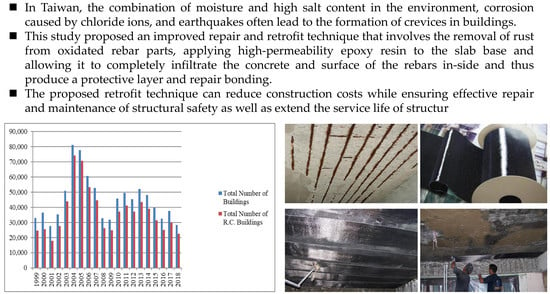Discussion on the Reinforcement of Reinforced Concrete Slab Structures
Abstract
:1. Introduction
1.1. Research Background and Motivation
1.2. Objectives
2. Literature Review
2.1. RC Materials and Structural Behaviors
- Creating a chemical adhesive force, or cementing force, on the interface between rebars and concrete,
- Producing friction by causing concrete to shrink and grasp rebars tightly,
- Increasing the grip between rebars and concrete by making raised bamboo joints on the surface of rebars,
- Generating anchorage by attaching hooks or bends to the tops of rebars or adding short rebars or angle bars to the anchorage area through welding.
2.2. Concrete Cracking
- Internal stress is caused by shrinkage from hardening or drying, temperature and humidity changes, or chemical changes in the concrete. As the internal structure shrinks as a result, the binding effect of the structure prevents the alleviation of internal stress, leading to crack formation.
- External stress primarily manifests as fatigue caused by pressure, tension, shear force, bending moment, torsion, and vibration. These external forces produce corresponding resistant stresses when exerted on structures. Cracks emerge when the internal resistant stress is weaker than the external force.
2.3. Rebar Oxidation
2.4. Determination of Damage Level for RC Structures
- House tilt 394/H > 1/50: Demolition and reconstruction are required, regardless of the damage level.
- House tilt 1/100 ≤ △/H < 1/50: Although the damage to the main structure has not threatened safety, a structural seismic resistance assessment must be conducted. The assessment project includes structural systems, structural details, structural status, and quantitative analysis. After the safety is confirmed by the structural seismic resistance assessment, the repair and reinforcement assessment are performed.
- House tilt 1/200 ≤ △/H < 1/100: There are no safety concerns in the house, and the repair plan can be planned according to the damage situation. Performing a retrofit plan based on current damage state of the structure and functional requirements of the building (such as an increase in the load caused by changing the function of the house).
- House tilt △/H < 1/200: The houses are safe. Local repair can be performed depending on the conditions of the houses; no retrofit is required.
3. Repair and Retrofit of RC Structures
3.1. Differences between Repair and Retrofit
3.2. Types of Retrofit
- Strength resistance-type retrofit: This method focuses on enhancing the strength of a building. This type typically involves such retrofitting efforts as thickening existing shear walls, filling wall crevices, or adding shear walls or steel braces. However, although this technique can considerably enhance the stiffness of buildings, the toughness is relatively poor.
- Endurance resistance-type retrofit: This method focuses on enhancing the nonelastic deformation capacity (toughness) of the building. This method typically involves such retrofitting efforts as enhancing the shear resistance of RC columns, ensuring the flexural endurance of RC beams or increasing the toughness of the steel beam-column joints.
- Strength and toughness resistance-type retrofit: This method focuses on simultaneously enhancing the building’s strength and toughness. This method typically involves such retrofitting efforts as adding seismic-resistant walls or braces or decreasing the centers of stiffness and mass to achieve balance in structural deployment.
- RC beam shear reinforcement-type retrofit: This reinforcement is provided with steel plates on the side and bottom of the beam and is fixed to the RC beam by chemical anchor bolts to improve the shear resistance of the RC beam.
3.3. Retrofitting Techniques of RC Structures
- Grouting epoxy resin into crevices: Applying pressure grouting to structural crevices with a width of ≥0.3 mm that are located in the RC beams, columns, slabs, or walls until the crevices are completely filled. This technique can repair damaged structural components and prevent rebar rusting caused by moisture infiltration.
- First eliminating loose concrete parts and then repairing with an epoxy resin grout: The Italian National Research Council [26] has highlighted the importance of a quality control that includes the determination of concrete conditions, removal of any deteriorated or loose concrete, cleaning and protection from corrosion of existing steel reinforcement, and finally, substrate preparation for receiving the selected FRP reinforcement. In accordance with this standard, once the quality control of the substrate has been performed, the deteriorated concrete has been removed, the concrete cross section has been restored, and the existing steel reinforcement has been properly treated, sandblasting of the concrete surface can be performed. In this guidance, it is pointed out that FRP or epoxy resin materials can obtain more effective seismic resistance. If severe cracking or loosening has been identified in local parts of an RC structural component, or if the entire component clearly exhibits no seismic capacity, then the repair team can remove the severely cracked or loosened parts. This process is done before repairing and retrofitting the structural component with an epoxy resin grout.
- Partial removing and rebuilding of a component: When the RC members are severely cracked, or the proportion of loose parts is too large to be filled with epoxy resin mortar, the components are partially knocked out and rebuilt.
- Cathodic protection technique: When rebar corrosion occurs in RC structures as a result of excessive chloride ion content (e.g., houses constructed with unwashed sea sand), the cathodic protection technique can be adopted to inhibit rebar corrosion.
3.4. Conventional Practices of RC Structure Repair and Retrofit
- Knocking out burst parts caused by rebar corrosion,
- Removing rust from rebars,
- Coating rusted rebars with antirust paint,
- Filling the spalling area with epoxy clay, and
- Wrapping the burst parts with carbon-fiber reinforced plastic (CFRP) patches.
3.5. Materials and Techniques of the RC Slab Retrofit Proposed in This Study
- CFRP patches: Externally bonded reinforcement (EBR) appeared in the 1980s [27]. In the last decades, fiber reinforced polymer (FRP) materials have been increasingly proposed to strengthen RC structures [28]. Significant investigation has been carried out in order to predict the bond strength of EBR systems with CFRP materials in concrete and, as a consequence of those studies, many analytical expressions can be found in the literature, including in standards [29]. Different strengthening techniques have been developed for applying FRP. Based on the above research, it is found that the reinforcement application has been proven to have a good effect on increasing the bearing capacity of the concrete plate, where the FRP laminate is glued onto the tensile face of the RC element [29]. A CFRP composite was obtained by extracting black organic materials from acrylic resin, petroleum, and coal, transforming these organic materials into fibers, and subjecting them to a special heat treatment. Table 2 presents the physical properties of the CFRP patches used in this study (displayed in Figure 5).
- Chemical anchor: Chemical anchors consist of a screw, chemical hose, washer, and nut; the chemical hose (or chemical agent tube packaged with plastics) contains a reactive resin, a curing agent, and quartz particles. Chemical bolts are used to facilitate the adherence of the angle steel, H-beam, beam side, and beam bottom steel plates to the concrete, thereby providing bonding and mechanical-occlusion forces to resist tensile strength and shear force.
- H-beam: The H-beams used in this study possess the features of a lightweight structure, favorable plasticity and toughness, and high structural stability and strength; therefore, H-beams are particularly appropriate for use in the structural retrofit of buildings in earthquake-prone areas. The H-beam is fixed on the reinforced concrete beam by chemical anchor bolts or welded to the reinforced steel beam, and the material characteristics of the steel are used to form the support beam, which can effectively improve the seismic resistance of the structure.
- Epoxy resin primer: The epoxy resin primer adopted was prepared at a mixing proportion of 2 (main agent): 1 (hardener) by weight. The viscosity was 1200–1600 cps, which is extremely suitable for capillary penetration. Its specific weight after mixing was 1.15, and the hardening time required was 4–6 h. The strength values of this epoxy resin primer are as follows:
- (1)
- Compressive strength (CNS 10142-2-11, ASTM D695, 25 °C—7 days) 700–800 kg/cm2
- (2)
- Bending strength (CNS 10142-2-10, ASTM D790, 25 °C—7 days) 500–600 kg/cm2
- (3)
- Tensile strength (CNS 2335-3-2, ASTM D638, 25 °C—7 days) 460 kg/cm2
- (4)
- Strength of the adhesive between the primer and concrete: (ASTM D1002, 25 °C—7 days) 100 kg/cm2
This primer grout exhibited no shrinkage after infiltration and hardening. It could completely coat rebars and thus prevent them from oxidation and the subsequent rusting caused by ambient moisture. Therefore, this primer produces a good consolidation of deteriorated concrete for RC structures. The compressive strength of the primer is extremely high, reaching 10,000 PSI or higher 7 years after application. Repair teams often disregard the value of work during this stage, and merely remove the deteriorated or spalled concrete parts. However, these repair teams were unware of hidden crevices inside the structures and only coated the rebars with a surface medium, which would eventually cause structural damage from continual rebar rusting and necessitate further repair. - Lightweight epoxy resin grout: The lightweight epoxy resin grout used in this study was prepared by aggregating and polymerizing lightweight hollow ceramic sand (lightweight sand) and lightweight powder with epoxy resin. This grout features light specific weight, favorable workability and durability, excellent strength, and simple application.
- Angle steel: Angle steels were adopted to affix both ends of the CFRP material.
4. Planning and Implementation Steps of RC Slab Repair and Retrofit and Case-Study Description
4.1. Planning and Implementation Steps of RC Slab Repair and Retrofit
- Surveying relevant information regarding existing RC buildings and structures:The research team surveyed the types and usage conditions of existing structures and documented the current conditions of buildings and structures using photographs and descriptions.
- Surveying the causes of structural damages sustained by existing buildings:The research team surveyed the causes of structural damages to determine whether they were related to inappropriate design changes or usage. Measurements, as well as structural safety and seismic assessments, were also performed to determine whether the structural damages were caused by natural deterioration, artificial errors, or natural disasters. Additionally, the team determined whether the structures would be usable after retrofit.
- Developing the repair and retrofit plan:The retrofit plan must satisfy the structure performance and safety requirements while remaining cost-effective. The repair and retrofit plan must be reviewed and approved by a government-certified technician, architect or engineering consultant before the repair and retrofit project can be carried out.
- Designing techniques used in the repair and retrofit efforts:The retrofit techniques used in this study consisted of coating the slab with CFRP materials, bracing the slab with H-beams, performing a vertical steel-plate retrofit to beams, installing chemical anchors for fixation, and filling the gaps between the steel plates and the beams with epoxy resin grout for adhesion.
- Conducting a postretrofit structural assessment:The postretrofit structural safety of buildings subjected to the retrofit must be conducted from the perspective of overall safety, such as through a structural seismic assessment. Experts and scholars may also be invited to review the RC structures after structural repair and retrofit.
- Implementing postretrofit structural maintenance and management:Routine assessments and surveillance investigations should be conducted on postretrofit structures every 2–3 years. Upon detection of a structural abnormality, the investigation results must be documented and photographed for maintenance and management purposes.
4.2. Construction Cases of RC Slab Repair and Retrofit
- The research team removed furniture in the house to prevent it from becoming dirty or damaged during construction. Sheets were paved on the floor for protection.
- The research team removed all loose and spalled parts of the concrete, used a grinder and other descaling tools to remove corroded parts on the rebar surface, and removed the entire stucco layer on the cement grout (Figure 6).
- The research team removed the stucco layer on the cement grout on the bottom and sides of the RC beams, performed a steel-plate retrofit where necessary, fastened steel plates to the beams with chemical anchors, and filled the gap between the steel plates and beams with an epoxy resin grout.
- Applying a rust-conversion agent to the rebars exposed from the slab for derusting and using antirust paint to protect the rebars from further corrosion.
- Applying a low viscosity epoxy resin to the slab base to enable it to completely infiltrate the structures (Figure 7).
- Where crevices were present in the slab, low-pressure grouting was employed when pouring the epoxy resin to ensure that all crevices were completely filled.
- Flattening extruding parts with a grinder and smoothing the entire area of the slab by evenly applying the lightweight epoxy resin grout or nonshrinkage cement (Figure 8).
- Placing H-beams (150 mm × 150 mm) perpendicular to the CFRP patches and welding the H-beams (small beams) onto the steel beams to brace the entire ceiling. Filling gaps between the H-beams and slab with nonshrinkage cement or epoxy resin grout (Figure 11). Epoxy resin expands when hardened; this property enabled CFRP patches to more closely adhere to the slab. In combination with the newly added H-beams, a satisfactory retrofitting effect could be achieved.
- If the slab to be retrofitted had undergone severe spalling, then H-beams could be installed first to brace the ceiling and prevent ceiling collapse. CFRP patches could be attached later by passing over the H-beams.
5. Results
6. Discussion
Author Contributions
Funding
Conflicts of Interest
References
- Chang, Y.-S. Life Cycle Assessment on the Reduction of Carbon Dioxide Emission of Buildings; Chenggong University: Tainan, Taiwan, 2002. (In Chinese) [Google Scholar]
- Shen, J.; Gao, X.; Li, B.; Du, K.; Jin, R.; Chen, W.; Xu, Y. Damage evolution of rc beams under simultaneous reinforcement corrosion and sustained load. Materials 2019, 12, 627. [Google Scholar] [CrossRef] [PubMed]
- Ng, T.S.; Yau, R.M.; Lam, T.N.; Cheng, V.S. Design and commission a zero-carbon building for hot and humid climate. Int. J. Low-Carbon Technol. 2016, 11, 222–234. [Google Scholar] [CrossRef]
- Cheng, Z.-L. Practice of zero carbon building. Tauwan Archit. 2017, 531. Available online: http://www.twarchitect.org.tw/special/%E9%9B%B6%E7%A2%B3%E5%BB%BA%E7%AF%89%E7%9A%84%E5%AF%A6%E8%B8%90/ (accessed on 30 October 2018). (In Chinese).
- Krzywiński, K.; Sadowski, Ł. The effect of texturing of the surface of concrete substrate on the pull-off strength of epoxy resin coating. Coatings 2019, 9, 143. [Google Scholar] [CrossRef]
- Gruszczyński, M. The use of thin cement-polymer layers to repair and strengthening concrete floors. Mater. Bud. 2018, 9, 30–33. [Google Scholar]
- Sadowski, Ł. Adhesion in Layered Cement Composites; Springer International Publishing: Cham, Switzerland, 2019. [Google Scholar]
- Directorate General of Budget, A.a.S., Executive Yuan, Statistics on Issued Building Licenses from 1999–2018. Available online: http://statdb.dgbas.gov.tw/pxweb/Dialog/varval.asp?ma=HC0102A1M&ti=%AE%D6%B5o%AB%D8%BFv%AA%AB%AB%D8%B3y%B0%F5%B7%D3-%AB%F6%BAc%B3y%A7O%A4%C0-%A4%EB&path=../PXfile/Construction/&lang=9&strList=L (accessed on 30 October 2018).
- Taipei City Government. Table of the Service Life and Annual Depreciation Rates of Building Improvements in Taipei City for the Purpose of Land Price Survey. Available online: http://www.land.gov.taipei/ct.asp?xItem=12519&CtNode=56902&mp=111001 (accessed on 28 September 2015).
- Lee, Y.S. Discussion with the Valuation Factors of Right Value when the Old-Mansion Is Reconstructed; Architecture and Building Research Institute, Ministry of the Interior: New Taipei City, Taiwan, 2005.
- Ministry of the Interior Executive Yuan. Urban Renewal Industry Action Plan; Ministry of the Interior Executive Yuan: Taipei, Taiwan, 2010.
- Ministry of the Interior. Rating System of the Hazard Level of Buildings Underwent an Earthquake and Evaluation Standards for Their Usage; Ministry of the Interior: Taipei, Taiwan, 1996.
- Tang, S.W.; Yao, Y.; Andrade, C.; Li, Z. Recent durability studies on concrete structure. Cem. Concr. Res. 2015, 78, 143–154. [Google Scholar] [CrossRef]
- Zhao, Y.; Jin, W. Steel Corrosion-Induced Concrete Cracking; Butterworth-Heinemann: Oxford, UK, 2016. [Google Scholar]
- Zhang, R.; Castel, A.; François, R. Concrete cover cracking with reinforcement corrosion of rc beam during chloride-induced corrosion process. Cem. Concr. Res. 2010, 40, 415–425. [Google Scholar] [CrossRef]
- Chen, C.H. Fundamental Research on Applying Rebar Implanting to Strengthen Concrete Structures; National Central University: Taoyuan City, Taiwan, 2001. [Google Scholar]
- Chinese Institute of Civil and Hydraulic Engineering. Strengthening of Existing Concrete Structures (Civil Engineering 405-94); Chinese Institute of Civil and Hydraulic Engineering: Taipei, Taiwan, 2005. [Google Scholar]
- Hsueh, C.-H. Retrofit of Rectangle rc Beams by Using Cfrp Wrapping and Chemical Anchors; National Taipei University of Technology: Taipei, Taiwan, 2009. [Google Scholar]
- Sánchez, M.; Faria, P.; Ferrara, L.; Horszczaruk, E.; Jonkers, H.M.; Kwiecień, A.; Mosa, J.; Peled, A.; Pereira, A.S.; Snoeck, D.; et al. External treatments for the preventive repair of existing constructions: A review. Constr. Build. Mater. 2018, 193, 435–452. [Google Scholar] [CrossRef]
- Li, V.C.; Horii, H.; Kabele, P.; Kanda, T.; Lim, Y.M. Repair and retrofit with engineered cementitious composites. Eng. Fract. Mech. 2000, 65, 317–334. [Google Scholar] [CrossRef]
- Mechtcherine, V.; Bruedern, A.; Urbonas, T. Strengthening/retrofitting of masonry by using thin layers of sprayed strain-hardening cement-based composites (sshcc). In Proceedings of the 4th International Conference on Concrete Repair, Dresden, Germany, 26–28 September 2011; pp. 451–460. [Google Scholar]
- Kobayashi, K.; Iizuka, T.; Kurachi, H.; Rokugo, K. Corrosion protection performance of high performance fiber reinforced cement composites as a repair material. Cem. Concr. Compos. 2010, 32, 411–420. [Google Scholar] [CrossRef]
- Kunieda, M.; Rokugo, K. Recent progress on hpfrcc in japan required performance and applications. J. Adv. Concr. Technol. 2006, 4, 19–33. [Google Scholar] [CrossRef]
- Rokugo, K.; Kanda, T.; Yokota, H.; Sakata, N. Applications and recommendations of high performance fiber reinforced cement composites with multiple fine cracking (hpfrcc) in japan. Mater. Struct. 2009, 42, 1197. [Google Scholar] [CrossRef]
- Lin, R.C. Feasibility study on the manual of emergency repair and reinforcement of damaged reinforced concrete buildings after the 921 earthquake. Mod. Constr. 2000, 245, 37–46. [Google Scholar]
- Council, N.R. Guide for the Design and Construction of Externally Bonded frp Systems for Strengthening Existing Structures; Advisory Committee on Technical Recommendations for Construction: Rome, Italy, 2013; Volume CNR-DT 200R1. [Google Scholar]
- Czaderski, C.; Meier, U. Ebr strengthening technique for concrete, long-term behaviour and historical survey. Polymers 2018, 10, 77. [Google Scholar] [CrossRef]
- Bank, L.C. Composites for Construction: Structural Design with frp Materials; John Wiley & Sons: Hoboken, NJ, USA, 2006. [Google Scholar]
- Soares, S.; Sena-Cruz, J.; Cruz, J.R.; Fernandes, P. Influence of surface preparation method on the bond behavior of externally bonded cfrp reinforcements in concrete. Materials 2019, 12, 414. [Google Scholar] [CrossRef] [PubMed]
- Valluzzi, M.; Grinzato, E.; Pellegrino, C.; Modena, C. Ir thermography for interface analysis of frp laminates externally bonded to rc beams. Mater. Struct. 2009, 42, 25–34. [Google Scholar] [CrossRef]
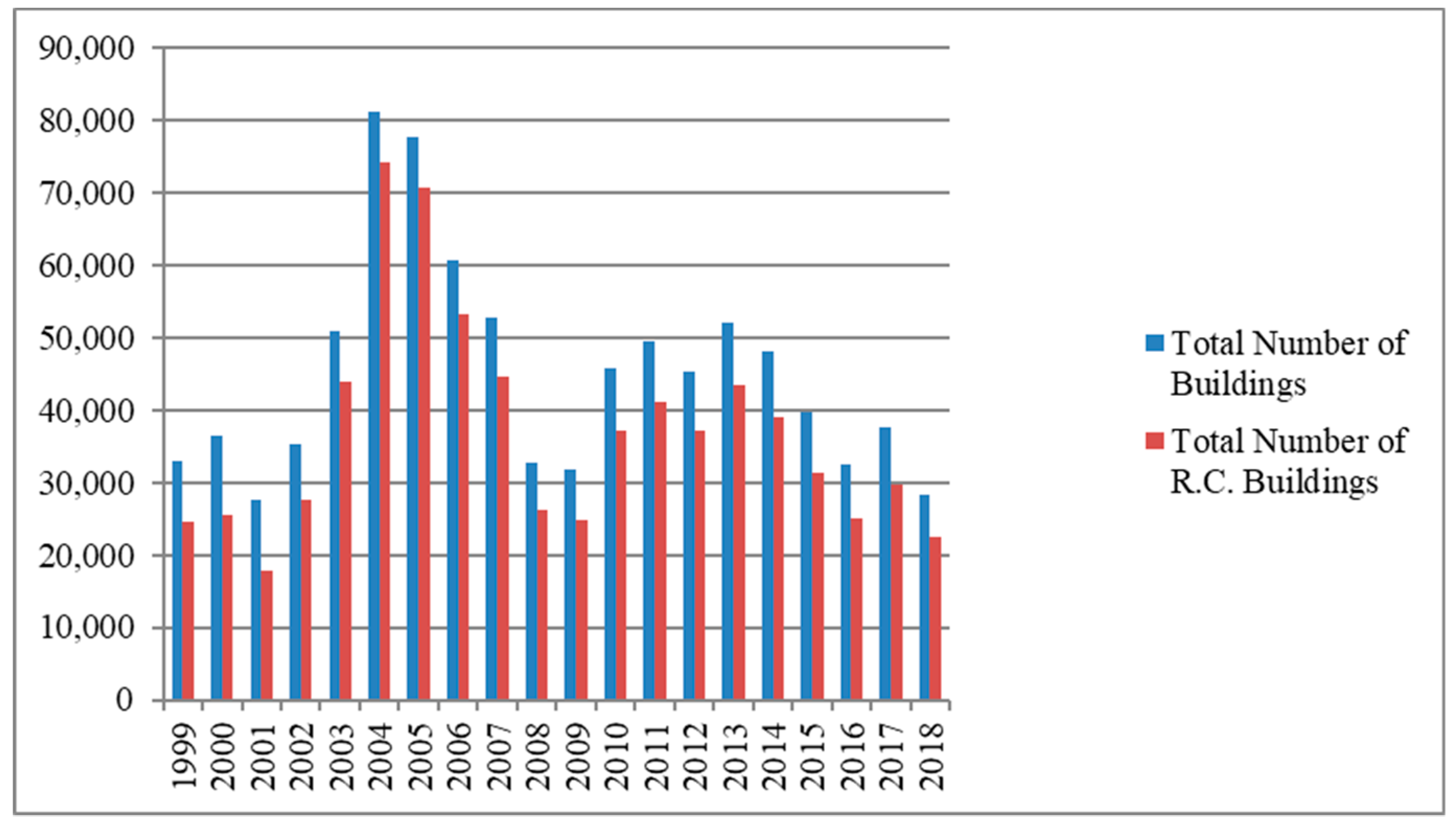
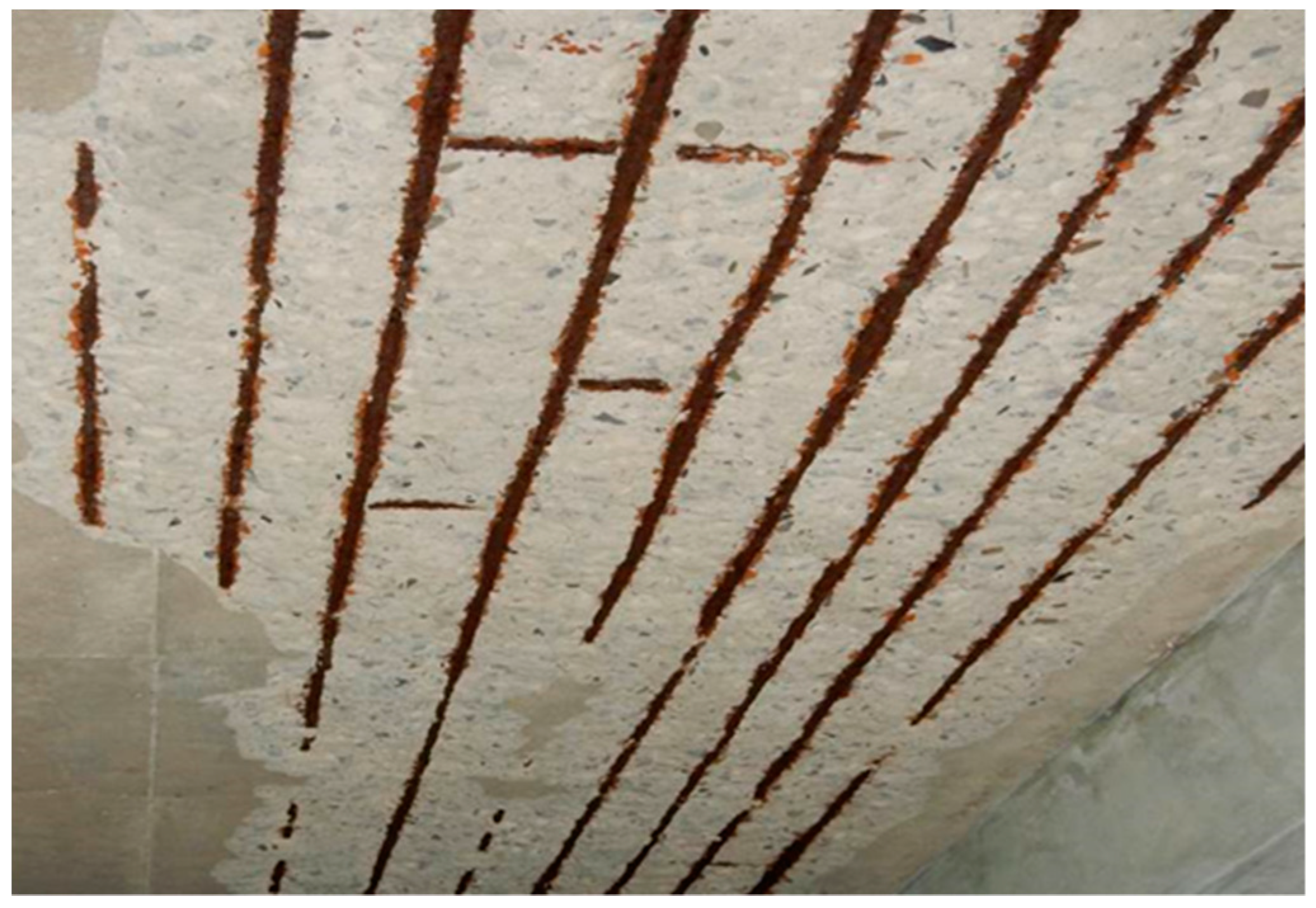
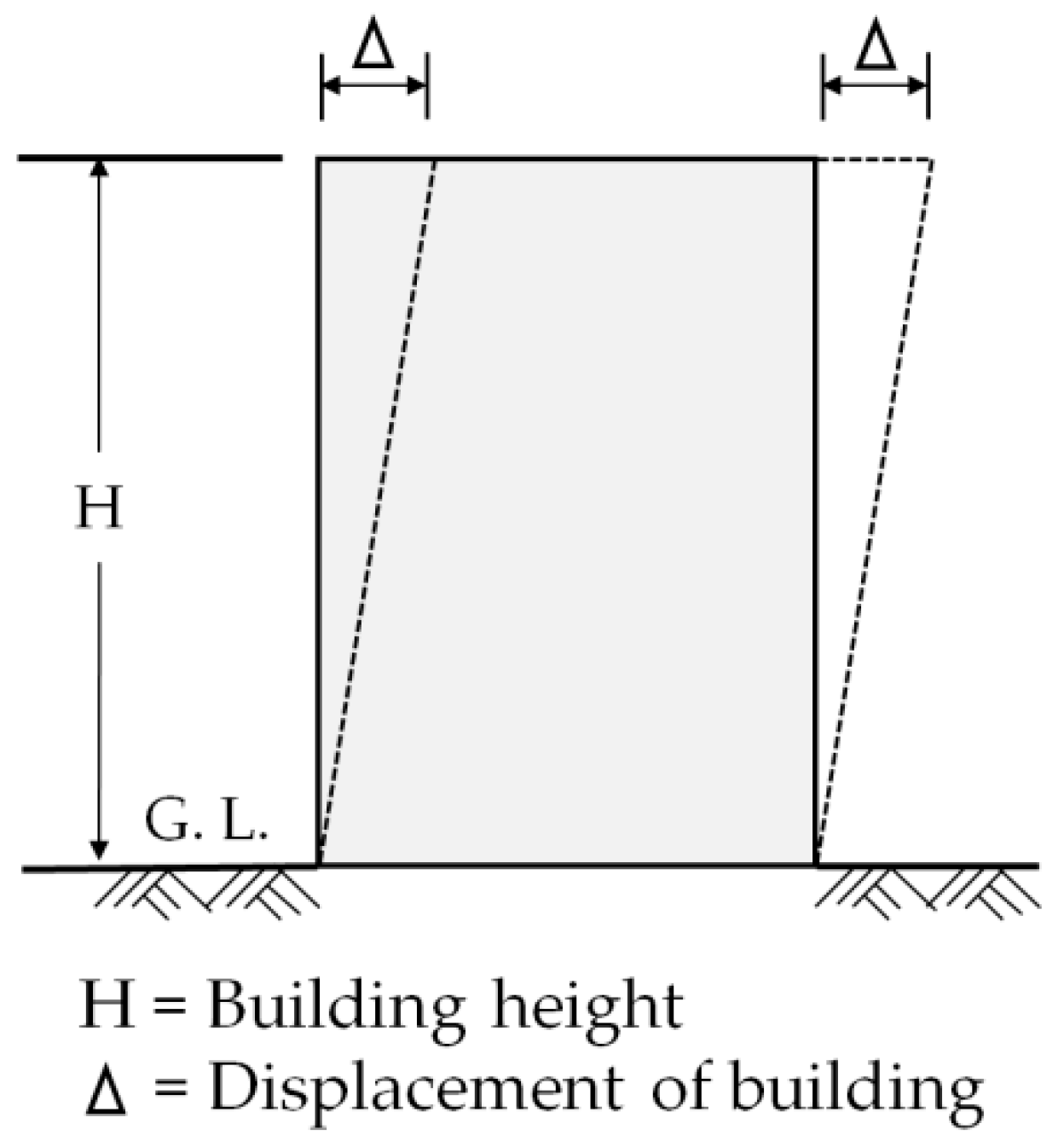

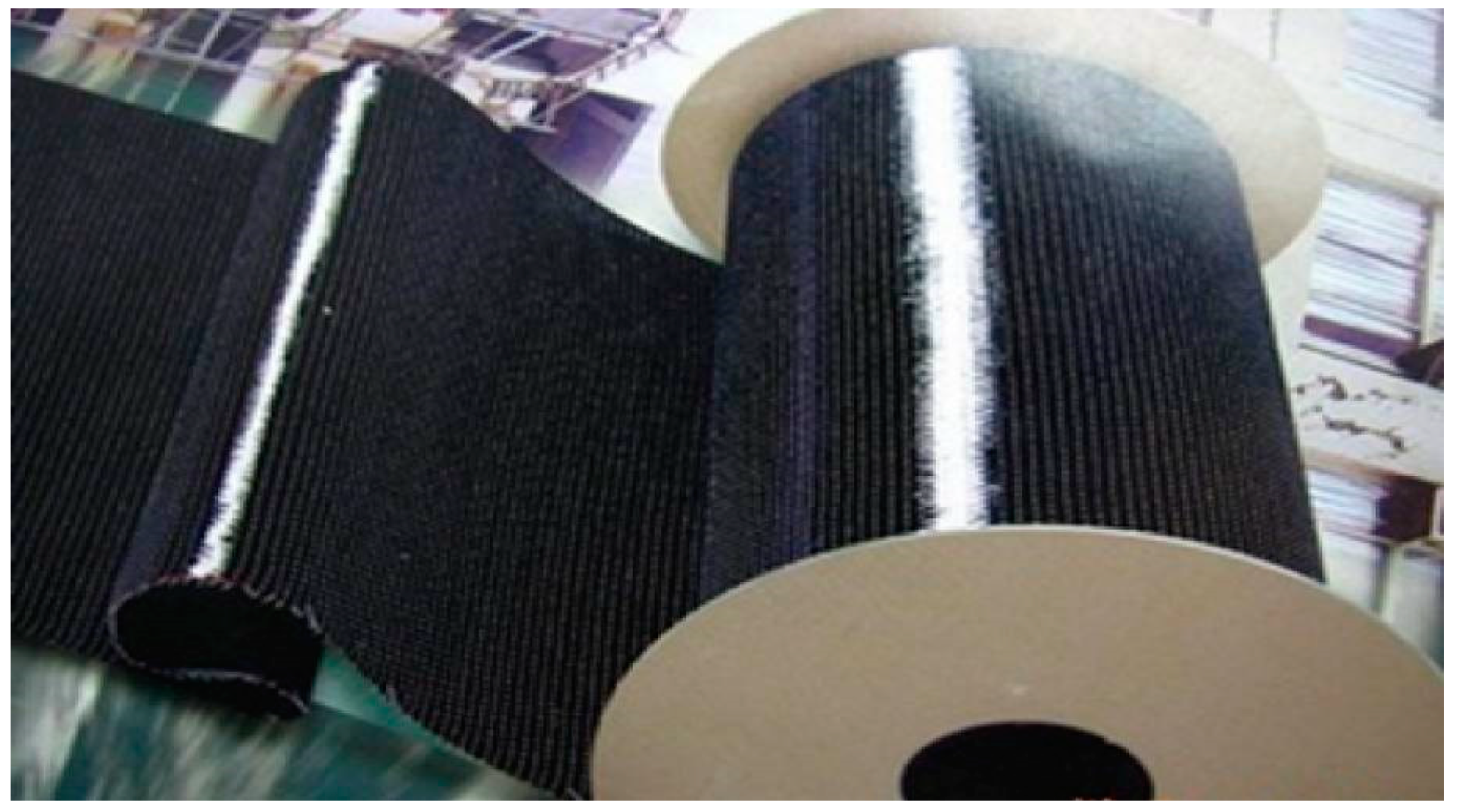
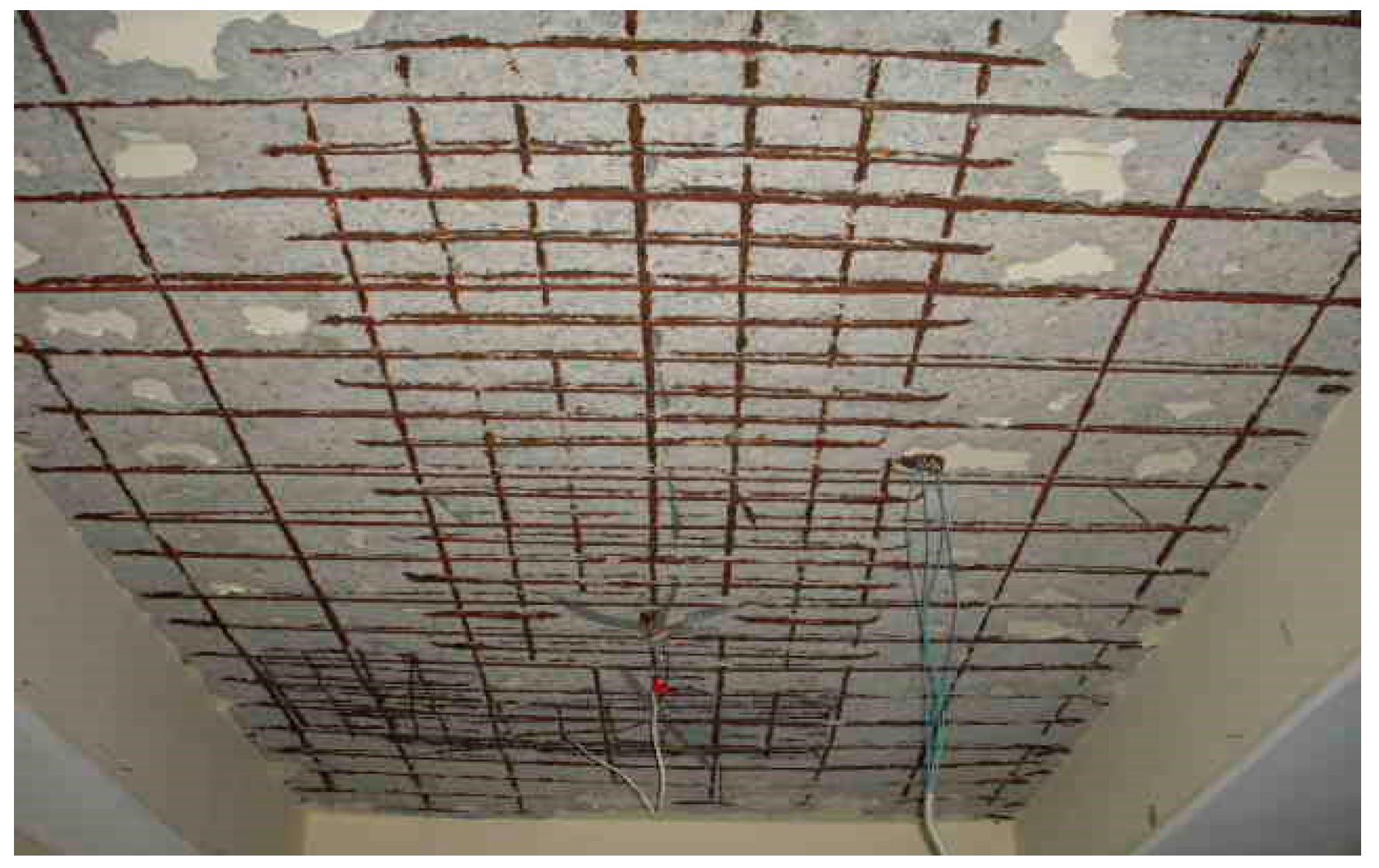

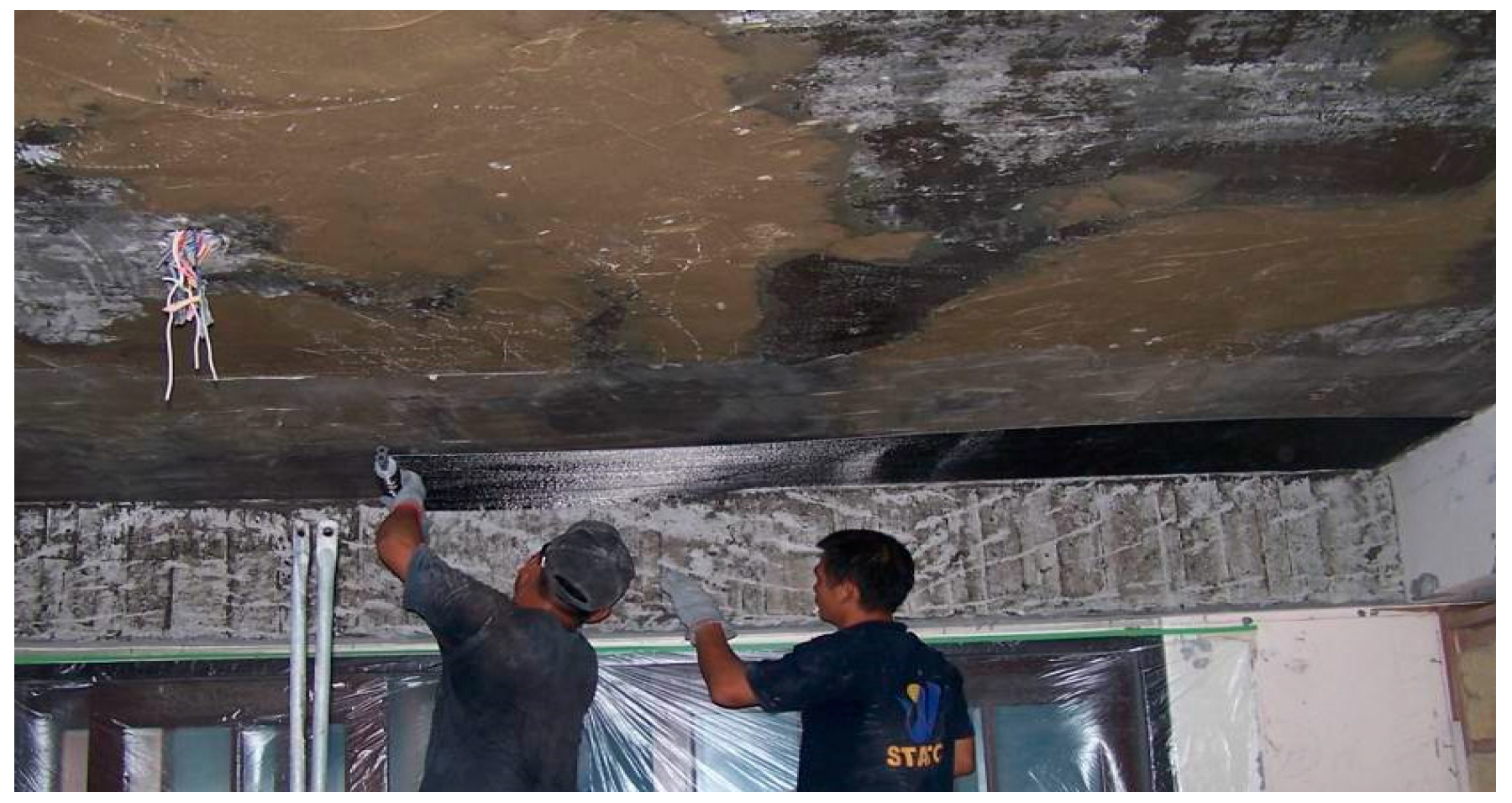




| Damage Level of RC Structures | Damage Details |
|---|---|
| I (Slight damage) | Crevices can only be identified upon close inspection (crevice width <0.2 mm) |
| II (Mild damage) | Crevices can be discerned with the naked eye (crevice width 0.2–1 mm) |
| III (Moderate damage) | Although relatively large crevices are present, spalling of the protective layer from the concrete is observed (crevice width 1–2 mm) |
| IV (Severe damage) | Numerous crevices wider than 2 mm, or severe concrete spalling is present with exposed rebars |
| V (Complete destruction) | Main rebar buckling, concrete cracking, column or shear wall vertical deformation, subsidence or tilting, or even rebar breakage |
| Physical Property | Glass Fiber Content (%) | Specific Weight | Tensile Strength (kg/cm²) | Compressive Strength (kg/cm²) | Bending Strength (kg/cm²) | Tensile Modulus (105 kg/cm²) | Heat Distortion Temperature (°C; Load 18.6 kg/cm²) | Combustibility |
|---|---|---|---|---|---|---|---|---|
| Value | 6070 | 1.8~2.0 | 3100~4300 | 1600~5000 | 3100~6400 | 1.8~2.5 | 120~190 | Combustible |
| Category | Strength (kg/cm²) | Note |
|---|---|---|
| Compressive strength | ≥765 | |
| Adhesive strength with steel materials | ≥102 | |
| Adhesive strength with concrete | 20–30 | Approx. 10–20% of the design strength of concrete (fc’) |
| Elastic modulus | ≥9.2 × 104 |
© 2019 by the authors. Licensee MDPI, Basel, Switzerland. This article is an open access article distributed under the terms and conditions of the Creative Commons Attribution (CC BY) license (http://creativecommons.org/licenses/by/4.0/).
Share and Cite
Hsu, W.-L.; Liu, C.-C.; Shiau, Y.-C.; Lin, W.-C. Discussion on the Reinforcement of Reinforced Concrete Slab Structures. Sustainability 2019, 11, 1756. https://doi.org/10.3390/su11061756
Hsu W-L, Liu C-C, Shiau Y-C, Lin W-C. Discussion on the Reinforcement of Reinforced Concrete Slab Structures. Sustainability. 2019; 11(6):1756. https://doi.org/10.3390/su11061756
Chicago/Turabian StyleHsu, Wei-Ling, Chen-Chung Liu, Yan-Chyuan Shiau, and Wen-Chin Lin. 2019. "Discussion on the Reinforcement of Reinforced Concrete Slab Structures" Sustainability 11, no. 6: 1756. https://doi.org/10.3390/su11061756





